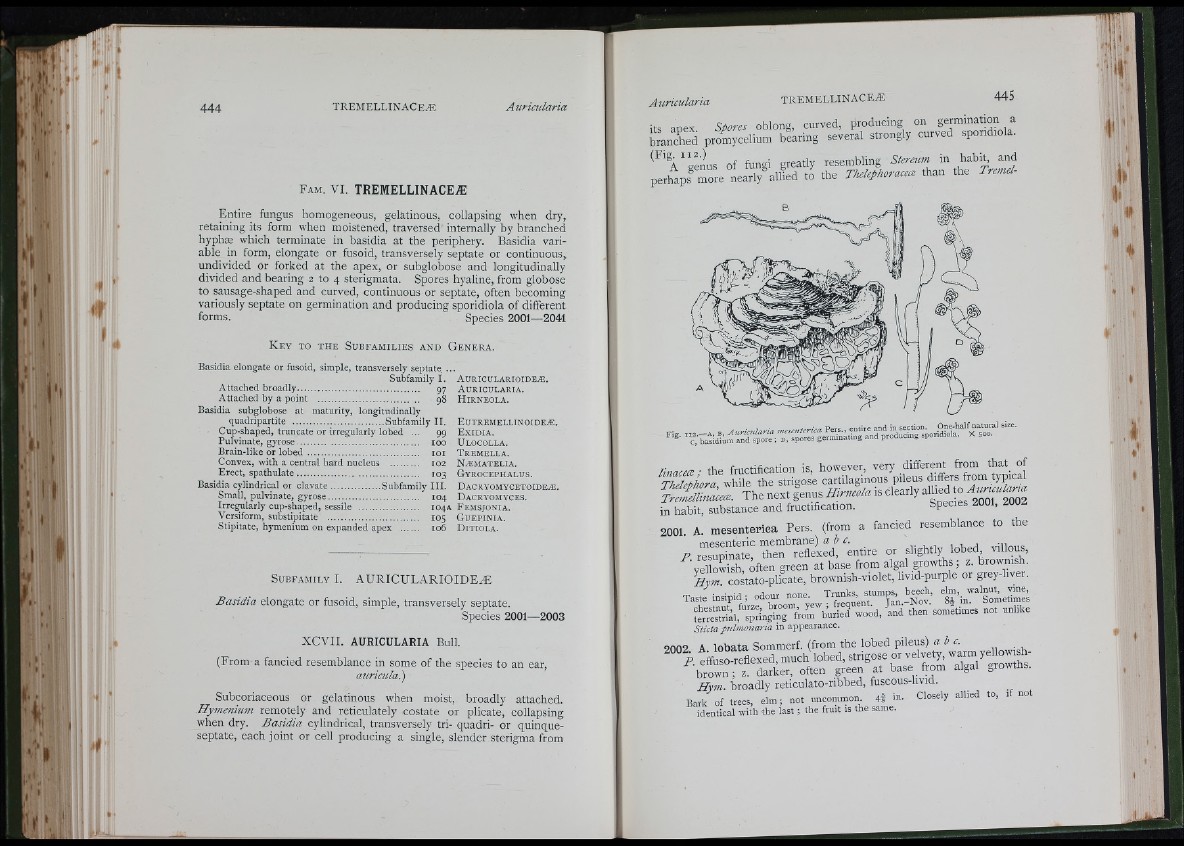
•y f, ! .
H I
r
444 t r e m e l l in a c e æ Auricularia
Fam. VI. TREMELLINACEÆ
Entire fungus homogeneous, gelatinous, collapsing when dry,
retaining its form when moistened, traversed internally by branched
hyphæ which terminate in basidia at the periphery. Basidia variable
in form, elongate or fusoid, transversely septate or continuous,
undivided or forked at the apex, or subglobose and longitudinally
divided and bearing 2 to 4 sterigmata. Spores hyaline, from globose
to sausage-shaped and curved, continuous or septate, often becoming
variously septate on germination and producing sporidiola of different
forms. Species 2001—2041
K ey to the Subfamilies a n d Ge n er a .
Basidia elongate or fusoid, simple, transversely septate ...
Subfamily I. A ü r ic u l a r io id eæ .
Attached broadly......................................................... 97 A u r ic u l a r ia .
Attached by a point ............................................... 98 H ir n eo la .
Basidia subglobose at maturity, longitudinally
quadripartite .....................................Subfamily II. E u t r em e l l in o id eæ .
Cup-shaped, truncate or irregularly lobed ... 99 ExiDIA.
Pulvinate, gyrose .................................................. lo o U locolla.
Brain-like or lobed ............................................... l o i T rem e lla .
Convex, with a central hard nucleus .............. 102 N æ m a t e l ia .
Erect, spathulate................................................. 103 Gyr o c e ph a lu s .
Basidia cylindrical or clavate.................... Subfamily III. D acryomycetoideæ.
Small, pulvinate, g y r o s e ............................................. 104 D acryomyces.
Irregularly cup-shaped, sessile ........................ 104A F emsjonia.
Versiform, substipitate ............................................. 105 Gu e p in ia .
Stipitate, hymenium on expanded apex ........... 106 D it iola.
Subfamily I. AURICULARIOIDEzE
Basidia elongate or fusoid, simple, transversely septate.
Species 2001—2003
XCVII. AURICULARIA Bull.
(From a fancied resemblance in some of the species to an ear,
auricula)
Subcoriaceous or gelatinous when moist, broadly attached.
Hymenium remotely and reticulately costate or plicate, collapsing
when dry. Basidia cylindrical, transversely tri- quadri- or quinque-
septate, each joint or cell producing a single, slender sterigma from
■A ■-
1*11
Auricularia TREMELLINACEÆ 445
its anex Spores oblong, curved, producing on germination a
L a n c h e d promycelium bearing several strongly curved sporidiola.
A “ genus of fungi greatly resembling Stereum in habit, and
p e rh ap sL ro re n e a rly L llie d to the Thelephoraceæ than the Tremelr
'
1;
7* fmrtifirfition is however, very different from that of
^ T hM while the strigose cartilaginous pileus differs from typical
T h e „ e x , g V u . « c , „ . y a m e d
in habit, substance and fructification. bpecies 2UU1, /uu
2001 A. mesenteriea Pers. (from a fancied resemblance to the
” e f U r . o. slightly lobed v illo .j
’yellowish, often green at base from algal growths; z. brownish.
Hym. costato-plicate, brownish-violet, hvid-purple or grey-liver.
Taste in s ip id ; odour none. Trunks stumps^ K e c h , d “ *.
" L ,L p r i n g L ° L o i r b ; r r i e d woéd, and then sometimes not unlike
Sticta pilmonaria in appearance.
9002 A lohata Sommerf. (from the lobed pileus) a b c .
P t&so-reflexed, much lobed, strigose or velvety, warm yel ow sh
brtavn; z. darker, often green at base from algal growths.
Hym. broadly reticulato-ribbed, fuscous-hvid.
Bark of trees, elm; not uncommon 4 f in. Closely allied to, if not
identical with the la st; the fruit is the same.
I I'